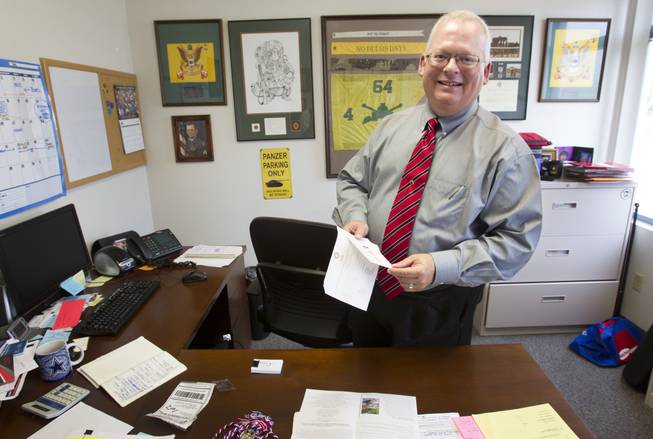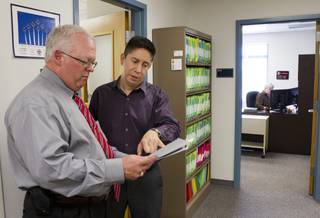
Ross Bryant, director of UNLV’s Office of Veteran Services, is shown in his office at the center Tuesday, July 31, 2012. Bryant is retired from the U.S. Army and is the center’s first director.
Friday, Aug. 3, 2012 | 2 a.m.
Ross Bryant’s business card is telling of the kind of outreach he is championing for active military and veteran students attending UNLV this fall.
The first director of UNLV’s newly formed Office of Veteran Services has his cellphone number listed prominently on his card. It’s there so veteran students can reach him day or night to talk about anything, Bryant said.
What the former career military officer doesn’t have on his card is also revealing.
Bryant — a retired Army major who saw the Berlin Wall fall in 1989 — doesn’t note his rank. That’s because he doesn’t want to create any barriers between him and his fellow veterans.
About 100,000 American soldiers will return home in the next five years as the U.S. military draws down from Iraq and Afghanistan. Many of the returning soldiers will go to college using the post-9/11 GI Bill benefits, and schools across the country are trying to prepare for an influx of veteran students.
Last year, UNLV served about 800 active-duty military, veteran and dependent students. That’s about 3 percent of the 28,000 students attending UNLV.
This coming school year, UNLV is anticipating serving 200 more veteran students — an increase of 25 percent.
“We’re trying to make sure we’re ready when they come,” Bryant said. “It’s like building the ark while the giraffes are arriving. We’re building it slowly but surely.”
UNLV isn’t blazing a trail with its Office of Veterans Services. The College of Southern Nevada, the largest higher education institution in the state serving one of its largest veteran student populations, opened its Veteran Education Center two years ago.
The center provides free computer access and printing to help veteran students file their GI Bill paperwork. A veterans affairs counselor also can meet with students who need help with classes and counseling.
The CSN center serves between 1,300 and 1,700 active military, veteran and dependent students each semester, according to Vanessa Robledo, its veterans affairs coordinator.
Next year, CSN anticipates 200 more students than last year, Robledo said.
“We’re already starting to see a large growth,” she said, citing the higher than average GI Bill filings.
•••
Bryant is on the front lines of a renewed effort by UNLV to receive and support this nontraditional group of students facing myriad challenges.
Veterans experience a cultural transition when they step out of their uniforms and step onto a college campus for the first time, Bryant said. It’s difficult to go from the structure and camaraderie of the military to the freethinking and unstructured environment of a university campus, he said.
Many veteran students are the first in their familes to go to college and may not know what to expect from university life, Bryant said. Some students may suffer from the physical and mental scars of war, he added.
“This is a population of students with special needs,” he said. “They come from a different background.”
Furthermore, the average age of a veteran student is between 24 and 27 years old, much older than the 18- to 22-year-old traditional college student. While college freshmen enjoy their first experience living on their own, these veteran students have already been there, done that.
“Veteran students have different motivations and goals,” Bryant said. “They’re very disciplined and have a laser focus. They want to move quickly onto the next chapter of their lives.”
That transition — from boots to books to briefcases — is an important one, Bryant said. That’s because the stakes are so high.
The unemployment rate among veterans between ages 18 and 24 last year was more than triple that of the national average of 8.2 percent, according to a recent Center for American Progress report on veterans.
Nearly a million veterans are living in poverty, and 1 in 7 are homeless, the Washington, D.C.-based nonpartisan nonprofit research group added.
Educating returning veterans has become the federal government’s next mission in combating the long odds for success facing this student demographic.
Under the post-9/11 GI Bill passed in 2008, veterans and their dependents are eligible for a three-year, $65,000 college scholarship that covers in-state tuition and gives an allowance for housing and textbooks.
This federal push — and to a large extent, the subsidy — has grabbed the attention of many colleges and universities across the country eager to attract veteran students to their campuses.
A recent Department of Defense symposium on education in Las Vegas drew hundreds of colleges and universities, many of them for-profit institutions criticized recently for using predatory recruiting methods to entice veteran students into sub-par programs.
Some of these pricy for-profit schools crammed into a large ballroom at the MGM Grand Convention Center, giving away trinkets such as green foam grenade “stress balls” and camouflage-colored book bags.
“Everybody wants these students, let’s be honest,” Bryant said, shaking his head at some of the recruiting methods. “But not a lot of schools have the resources we do. We really want to take care of this community.”
•••
Daniel Flores first encounter with college-level coursework was on an aircraft carrier deployed around the world. A professor from Central Texas College was working aboard his ship, teaching sailors introductory-level English and Algebra classes.
When a disability forced Flores to change his eight-year career with the Navy, the 36-year-old went to College of Southern Nevada and transferred to UNLV in 2009.
“It was scary,” he said. “I didn’t know what to expect. I thought I’m going to be the oldest person here.”
Through perseverance and dedication, Flores earned his bachelor’s degree in finance and his master’s degree in business administration within two years, thanks to the GI Bill. Flores, who is working on a second master’s degree and a doctorate in public health, works as a student worker going through GI Bill paperwork for UNLV’s new Office of Veteran Services.
“I wish we had something like this when I was here,” Flores said. “I struggled a little before; I felt like I didn’t have the support.”
Now, Flores hopes to change that, applying to become the center’s first veterans counselor.
“A lot of vets are nontraditional students,” he said. “A lot of veterans are combat veterans who come back with physical and psychological scars.”
•••
An American Council on Education survey of nearly 700 American colleges and universities released last week found that more institutions are providing programs and services designed specifically to serve veterans and military personnel.
This support includes a dedicated office to serve veteran students, veteran-specific counseling to assist with post-traumatic stress disorder, trained staff to help those veterans with disabilities and a veteran student lounge to aid in building a community among veteran students.
UNLV — which was named a military-friendly school by G.I. Jobs Magazine in 2011 — has instituted all of these special services geared toward veteran students over the past several years, Bryant said.
However, all of these services were located on different campuses and offices, which made it difficult for veteran students to navigate college. With the formation of a new Office of Veteran Services, these efforts have crystallized into a sort of one-stop-shop for veteran students.
“This is sort of cutting-edge,” Bryant said.
First and foremost, the office helps veteran students apply for their GI Bill benefits, which must be renewed each semester. The office processes hundreds of applications each semester, each taking about 20 minutes to complete — a massive undertaking, Bryant said.
The center also will provide a special veterans counselor to help with myriad issues — academic, physical and psychological, Bryant said.
Outreach won’t occur just with veteran students, Bryant said. A recently created training program called Serving Every Returning Veteran is a once-a month orientation that teaches professors how to interact with veteran students by teaching military lingo and how to recognize symptoms of PTSD.
Professors who complete this training receive a sticker to display in their classroom and office to demonstrate a safe zone for veteran students, Bryant said, adding it’s about changing the culture of the military to seek help.
The office is also reaching out to the greater Las Vegas community, especially veterans organizations, Bryant said. There are several networking events planned for the coming year, especially to help connect students with internships and job opportunities.
The Las Vegas Rotary Club will envelop veteran students from UNLV into its organization after graduation, Bryant said. The local American Legion chapter has agreed to sponsor UNLV’s Student Veterans Organization.
The office is also working to get several scholarships for veteran students, especially out-of-state students. Nevada — unlike Texas, Florida and Missouri — doesn’t allow out-of-state veteran students to receive in-state tuition rates.
It’s something Bryant said he would like to see changed in Nevada. After all, these veterans served their entire country, not individual states, he said.
•••
UNLV junior Dustin Cather is president of the Student Veterans Organization, a local chapter of a national organization that connects veteran students.
“We’re out to help each other out,” Cather, 28, said, of UNLV’s new veterans center that also hosts SVO. “It’s a comfort zone for like-minded people. We have a lot of support here.”
The center has been helpful to many of Cather’s fellow veteran students who don’t understand all the benefits available to them. The self-described “military brat” said his mother — a veteran who graduated from UNLV in the 1990s — helped him navigate the bureaucracy of the Veterans Affairs system.
“It’s a little confusing,” he said. “There’s a lot to know.”
•••
Bryant is still putting the finishing touches into his new office on the third floor of the student services building on the Maryland Parkway campus. A new logo and flags are still to be delivered.
Despite being new, the office is already steeped in tradition.
Five colorful military seals adorn a wall, welcoming veteran students from all branches of the military.
A special plaque sits above a computer workstation where veteran students can fill out their GI Bill paperwork. On the plaque is a photo featuring Karen Wagner, a 1982 UNLV graduate who was killed on 9/11 while working at the Pentagon. A brick from the rubble is displayed below.
A short walk away, UNLV’s Veterans Memorial is lit 24 hours a day. The bronze structure depicts a “fallen solider battle cross” made up of a rifle, empty boots and helmet representing a soldier killed in service. Bryant — a former ROTC commander at UNLV — helped dedicate the memorial when it was unveiled on Sept. 11, 2010.
New traditions are being developed. During the university’s most recent graduation ceremony, veteran student graduates wore special red, white and blue cords and were given commemorative “Rebel Vets” coins, a Vietnam War-era tradition that started in the Army.
Bryant carries his own coin, too. His is a bronze-colored one, its faded print hinting at his service in the Army operating tanks in far flung countries such as Germany, Kuwait and Egypt.
Helped himself by the Montgomery GI Bill, Bryant now sees it as his duty to help younger veterans navigate college and post-secondary opportunities.
UNLV is serious about helping veteran students every step of the way, Bryant said.
“The university just said this was just the right thing to do.”


Join the Discussion:
Check this out for a full explanation of our conversion to the LiveFyre commenting system and instructions on how to sign up for an account.
Full comments policy